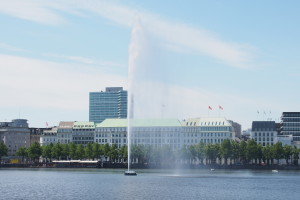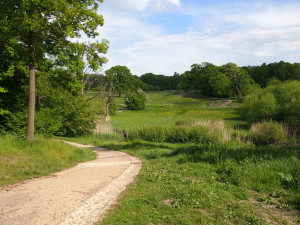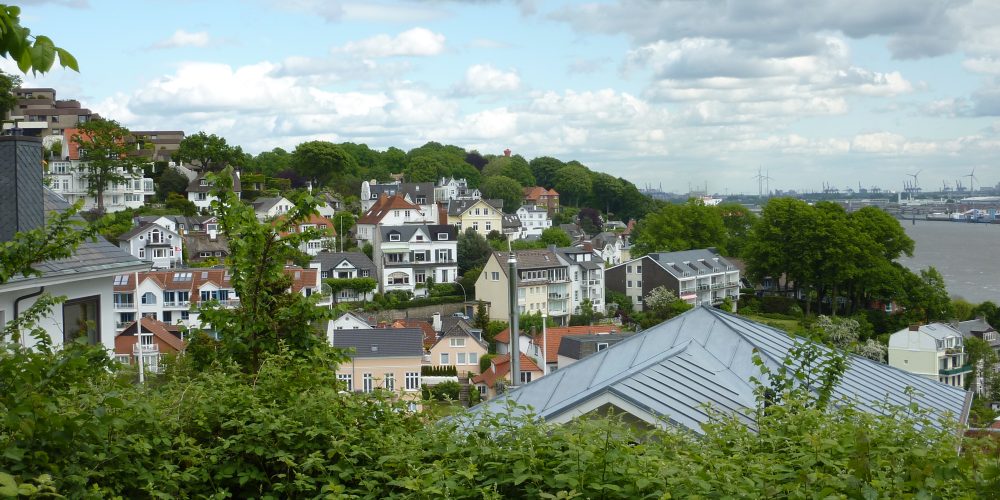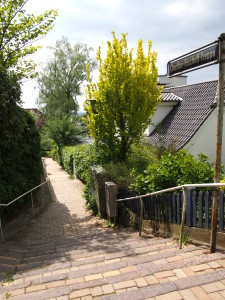 Wednesday, 10:30 a.m. at ATG ferry pier 3: A lively group of women in their prime disembark from the historic steamship St. Georg. We introduce ourselves and start our tour with a bus already waiting at Ballindamm. Once around the Binnenalster, we take a look at the outside of the building that we have just seen from the water. We continue along the Glockengießerwall, Hamburg’s former city fortifications, to Mönckebergstraße, the shopping street with the highest turnover. We ride past the town hall and the stock exchange, past Rödingsmarkt, Hamburg’s oldest railroad line, via Gänsemarkt to Gorch-Fock-Wall. Turning left, we can admire Hamburg’s beautiful green belt in the former fortifications and, with a detour into Peterstraße, we can even see a bit of the Hanseatic city’s building tradition in the composers’ quarter.
Wednesday, 10:30 a.m. at ATG ferry pier 3: A lively group of women in their prime disembark from the historic steamship St. Georg. We introduce ourselves and start our tour with a bus already waiting at Ballindamm. Once around the Binnenalster, we take a look at the outside of the building that we have just seen from the water. We continue along the Glockengießerwall, Hamburg’s former city fortifications, to Mönckebergstraße, the shopping street with the highest turnover. We ride past the town hall and the stock exchange, past Rödingsmarkt, Hamburg’s oldest railroad line, via Gänsemarkt to Gorch-Fock-Wall. Turning left, we can admire Hamburg’s beautiful green belt in the former fortifications and, with a detour into Peterstraße, we can even see a bit of the Hanseatic city’s building tradition in the composers’ quarter.
 The brief glimpse of Hamburg’s main church, St. Michaelis, is clearly too short, but today we are on our way to Blankenese. Our route takes us directly across the Reeperbahn, with a detour through Große Freiheit. Here we understand why this no man’s land between Hamburg and Altona has developed the way it is today. But then we head west past the St. Pauli fish market. Via the Palmaille, the Elbchaussee – past the magnificent villas that bear witness to a time of prosperity – we reach the foot of Jenischpark, today the largest Elbpark in Hamburg. Herrmann, our bus driver, lets us off here and we wander through the beautiful park until we arrive at the café and the greenhouses. Now we have half an hour to take a breather, which can be used for coffee, museum, greenhouse and toilet.
The brief glimpse of Hamburg’s main church, St. Michaelis, is clearly too short, but today we are on our way to Blankenese. Our route takes us directly across the Reeperbahn, with a detour through Große Freiheit. Here we understand why this no man’s land between Hamburg and Altona has developed the way it is today. But then we head west past the St. Pauli fish market. Via the Palmaille, the Elbchaussee – past the magnificent villas that bear witness to a time of prosperity – we reach the foot of Jenischpark, today the largest Elbpark in Hamburg. Herrmann, our bus driver, lets us off here and we wander through the beautiful park until we arrive at the café and the greenhouses. Now we have half an hour to take a breather, which can be used for coffee, museum, greenhouse and toilet.
After some confusion as to how many of us there should be, we all find each other on the bus and start our journey to Blankenese. There we meet Gabriele, our second tour guide. The group is divided into sporty and not so sporty groups – although there is not much difference in Blankenese. So one group walks with Gabriele through Blankenese’s staircase district and one group with me. We visit Gossler’s Park, Hesse Park and some of the stairs. Passing many old and beautiful houses, we can enjoy the great view and stop every now and then in amazement. But be careful! The steps are not necessarily the same height. Once we reach the bottom of the beach, we take a short break in the sun. It’s easy to imagine that this is where the nobility of society went for a swim and spent their “summer retreat”. After a difficult climb of around 120 steps, the last part of the route begins. Exhausted but happy, after a few poems we reach the Schuldt coffee garden with its incredible view over the Elbe. Coffee and cake make up for the exertions and the way back to Blankenes station is not so difficult either on the “Bergziege” (line 48) or on foot. We say goodbye at the station and I hope that the ladies from Hude have fond memories of Hamburg!


